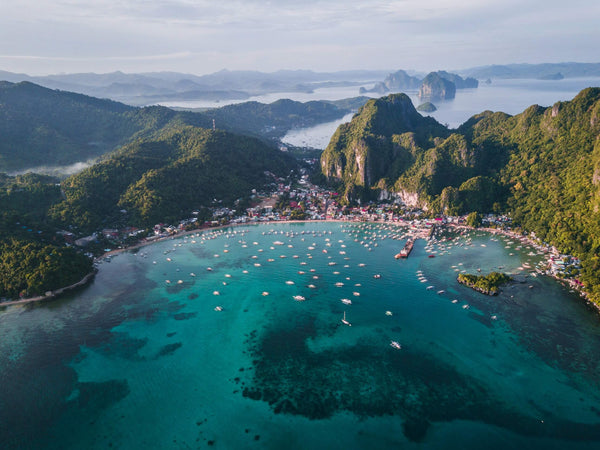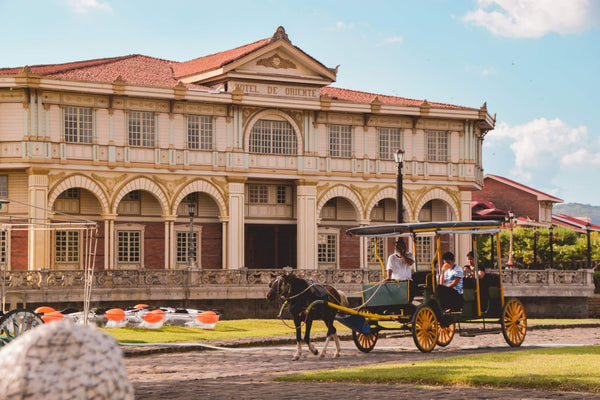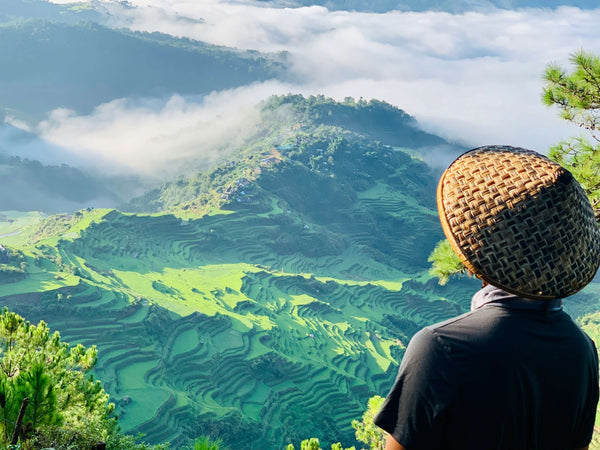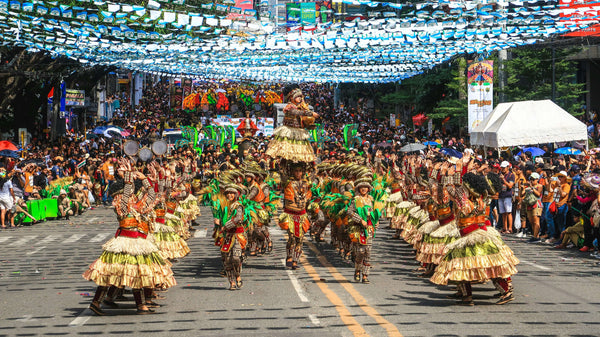Are you thinking of a trip to the Philippines? Well let me tell you, the Philippines is an incredible destination with so much to offer!
There's Palawan that's like stepping into paradise with its stunning beaches, crystal-clear waters and stunning limestone cliffs. Then there's El Nido and Coron in Palawan, famous for their island-hopping tours where you can explore hidden lagoons, coral reefs, and beautiful beaches.
If you like city life and lots of culture then Manila, the capital, has a lot to offer. Intramuros, the old walled city, has a rich history and you can explore the markets plus the nightlife is great.
And if you like activity and adventure then don't miss out on the chocolate hills in Bohol or the famous surfing spots in Siargao. If you're a fan of underwater adventures, the Philippines has some of the best diving and snorkelling spots in the world, like Apo Reef and Tubbataha Reefs Natural Park.
No matter what you're into – whether it's relaxation on stunning beaches, exploring cities or want an adventure – the Philippines has something for you!

So when is the best time to visit the Philippines?
Lets first look at its weather.
Weather in the Philippines
The climate in the Philippines is generally warm and humid throughout the year, but it does vary depending on the season and region.
There are two main seasons: the dry season and the rainy season. The dry season runs from November to April, while the rainy season is from May to October.
During the dry season, the weather is sunny with little to no rainfall. Temperatures can range from around 77°F (25°C) to 95°F (35°C) in most areas, although it can feel hotter due to the high humidity levels. It’s a perfect time to visit if you're looking for beach weather and outdoor activities.
The rainy season, however, has frequent rainfall and occasional typhoons, especially from June to September. Temperatures stay warm, ranging from 77°F (25°C) to 86°F (30°C), but the humidity can make it feel stickier. Rainfall can vary greatly depending on the region you are in with some areas experiencing heavy downpours and others lighter showers. It's still possible to enjoy your trip during this time, but it's important to pack rain gear and plan indoor activities just in case.
Lets now look at the seasons in more detail
Peak Season in the Philippines – December to May
Visiting the Philippines during its peak season, which runs from December to May, is an experience! With its stunning beaches, crystal-clear waters, lively festivals filling the streets with music and colour and a warm tropical breeze gently swaying the palm trees, it's like stepping into paradise!
One of the biggest reasons to visit during the peak season is the weather. With lots of sunshine and hardly any rainfall, it's the best time to get involved in all sorts of activities, including island hopping, snorkelling or lying on the beach with a coconut and if you like diving then it’s the best time to explore the Philippines' diverse marine life and beautiful coral reefs.
The peak season also coincides with several lively festivals and celebrations including the Ati-Atihan Festival and the Sinulog Festival. These events will give you a fantastic insight into the rich culture and traditions of the Philippines, with street parades, traditional dances, and lots of local delicacies.
Of course the peak season is popular which means it can be busy and prices will generally be higher, especially in the more tourist spots of Boracay and Palawan, so, it's a good idea to plan and book accommodations and activities in advance to make sure you get the most out of your trip without breaking the bank or spending too much time waiting in queue.
Things to do in the Philippines during the Peak Season
- Explore the Stunning Beaches as the Philippines has some of the most beautiful beaches in the world, from the famous Boracay to the secluded El Nido. You can snorkel, dive or just relax and soak up the sun.
- Go island hopping as there are over 7,000 islands to choose from. You can hop from one island to another and find your perfect beach. They all have crystal-clear waters and lots of stunning marine life.
- Try Filipino Cuisine, from traditional dishes like adobo and sinigang to street food favourites like balut and halo-halo.
- Go to local festivals as the Philippines is well known for these especially during the peak season. You can join the festivities of the Ati-Atihan in Aklan, Sinulog in Cebu, or Dinagyang in Iloilo.
- Immerse yourself in the rich history of the Philippines by visiting historical sites such as Intramuros in Manila, Magellan's Cross in Cebu, and the UNESCO World Heritage-listed rice terraces in Banaue.
- Get your adrenaline pumping with adventure activities. You can hike to the crater of Mount Pinatubo, go surfing in Siargao, or canyoneering in Cebu.
- Explore Underground Rivers and discover the amazing underground rivers of Palawan, like the Puerto Princesa Subterranean River National Park, a UNESCO World Heritage Site, and one of the New Seven Wonders of Nature.
- Get up close and personal with unique wildlife in the Philippines. You can swim with whale sharks in Oslob, see tarsiers in Bohol or go dolphin watching in Panglao.
- Unwind and rejuvenate in natural hot springs that are scattered across the country. Whether it's the hot springs of Laguna or Camiguin, a relaxing soak is the perfect way to end the day.
- Go to local markets and experience the local culture in places like Divisoria in Manila or Carbon Market in Cebu, they will have everything you need and more.

Low Season in the Philippines – June to September
Visiting the Philippines during its low season means fewer crowds and more affordable prices.
The low season, which typically falls between June to September, is when the weather is a bit unpredictable with occasional rain showers but there is still plenty of sunshine to go around.
One of the nicest things about the low season is that you get to experience a more authentic side of the Philippines. You'll have the beaches and attractions practically to yourself, which means you can soak in its beauty without feeling rushed.
Plus, since it's not as busy, you'll have the chance to get to know the local people better and with fewer tourists around, accommodations, tours and even flights are often cheaper. So if you're looking to stretch your budget without compromising on your experiences, the low season is a good time to go.
Things to do in the Low Season in the Philippines
- Island Hopping, and while some islands may experience occasional rain showers, the weather is generally still warm and pleasant for exploring the stunning islands and beaches. You may find that you have some of the beaches all to yourself.
- Go Scuba Diving and Snorkelling as the Philippines is renowned for its incredible marine biodiversity. During the low season, dive sites are less crowded and you may spot some unique marine life that's more active during this time.
- Go on a Waterfall Exploration as the rainy season means waterfalls come to life in the Philippines. Visit some of the stunning waterfalls like Kawasan Falls in Cebu or Tinago Falls in Iligan.
- Explore the rich culture and heritage of the Philippines by visiting local communities, attending festivals and trying Filipino food. You'll have more opportunities to interact with locals and learn about their way of life.
- Try adventurous activities from zip-lining through forests to trekking to hidden caves, the Philippines has a bundle of adventurous activities that are perfect for the low season.
- Try a relaxation and spa retreats and treat yourself to some pampering at one of the many luxurious resorts and spas scattered across the islands.
- Explore the cities including Manila, Cebu and Davao during the low season without having to navigate through large crowds.
- The low season is an excellent time if you love wildlife. Head to places like Palawan or Bohol for the possibilities to see dolphins, whales and exotic birds.
Remember to check the weather forecast and plan your activities accordingly, but don't let the occasional rain shower deter you from experiencing all that the Philippines has to offer during the low season!

Shoulder season in the Philippines – November to April, June to October
The shoulder season in the Philippines is a sweet spot between the peak and off-peak periods. It typically falls between the high season, which runs from November to April, and the low season, which spans from June to October.
Visiting during the shoulder season is when you get to enjoy some perks without the crazy crowds and sky-high prices and is when you can explore the beautiful green landscapes and dive into crystal-clear waters without feeling like you're elbowing your way through a sea of tourists.
The weather is generally pretty good too, with fewer chances of rain and typhoons compared to the off-peak months.
So, if you're looking for that perfect balance of good weather, fewer crowds, and reasonable prices, the shoulder season in the Philippines might just be the perfect time to go.
Things to do in the Philippines during the shoulder season
- Go Island Hopping and explore the picturesque islands, like Palawan, Boracay, and Cebu. you can snorkel, dive or just relax on the beaches.
- Visit historical sites like Intramuros in Manila, the Chocolate Hills in Bohol, or the UNESCO World Heritage-listed rice terraces in Banaue.
- Try activities like surfing in Siargao, canyoneering in Cebu, or hiking to the crater lake of Mount Pinatubo.
- Sample the Filipino food, including adobo, sinigang, and lechon and don't forget to try street food favourites like balut (fertilized duck egg) and halo-halo (a refreshing dessert).
- Discover the rich biodiversity of the Philippines by visiting places like the Tarsier Sanctuary in Bohol, swimming with whale sharks in Oslob, or exploring the Underground River in Palawan.
- Get involved in festivals, like the Ati-Atihan Festival in Aklan, Sinulog Festival in Cebu, or MassKara Festival in Bacolod, which showcase the country's colourful traditions and heritage.
- Unwind with a rejuvenating spa treatment or yoga session at one of the many wellness resorts scattered across the islands.
- Explore the markets like Quiapo Market in Manila or Carbon Market in Cebu, where you can shop for souvenirs, fresh produce, and unique handicrafts.
- Make the most of the clear waters during the shoulder season and go snorkelling, diving, kayaking or paddleboarding.
- Try a sunset cruises visiting scenic spots like Manila Bay or the Bacuit Archipelago in Palawan with their breathtaking views and maybe enjoy a romantic dinner onboard.

When is the Philippines rainy season?
The rainy season in the Philippines is usually from June to November when there is a lot of rain, high humidity and the occasional typhoon. Though the exact timing and intensity can vary from year to year and from region to region within the Philippines, it's generally advisable, if you choose to go during these months to be prepared for it to be wet.
However the Philippines is beautiful all year round and the rain won’t ruin your trip. Just pack an umbrella and some waterproof gear, and you'll still have an amazing time.
Best time to visit the Philippines month by month
January
A fantastic time to visit as the weather is generally cool and dry, making it perfect for exploring cities and beaches without worrying too much about rain.
February
Similar to January, with lovely weather and hardly any rain, perfect for outdoor activities and island hopping.
March
Still in the dry season so great for beach and diving holiday, also a great time for festivals like the Panagbenga Festival in Baguio.
April
The temperatures start to rise in April but it's still a good time to visit before the onset of the rainy season. Make the most of the warm weather to try water sports and go sightseeing.
May
May is the beginning of the rainy season in the Philippines, so while it's still possible to visit, be prepared for occasional showers and try to plan indoor activities or trips to destinations less affected by rain.
June
Rain becomes more frequent in June, especially in the afternoons and evenings. It's still possible to travel, but worth packing waterproofs and planning activities around the weather.
July
This is one of the wettest months in the Philippines, so your travel may be affected by heavy rain and potential typhoons. Consider visiting destinations that are less prone to rain, such as the Banaue Rice Terraces.
August
Very similar to July, August with heavy rainfall and the chance of typhoons. However, if you don't mind rain, it can be a good time to visit as it’s a lot quieter.
September
This month is still rainy but a great time to go to museums and visit historical sites.
October
This is when the rainy season starts to taper off, so a transitional period between the wet and dry seasons. It’s better to visit towards the latter half of the month for the better weather.
November
This is the start of the dry season, so less rain and more sunshine, a great time to visit beaches and generally be outside the peak tourist season begins.
December
The temperatures are a bit cooler in December so a popular time for tourists, especially during the Christmas holidays. It's definitely worth booking accommodations and flights as the demand will be a lot higher at this time of year.
Overall, the best time to visit the Philippines depends on what you want to do when you are there so if you prefer dry weather, January to April is ideal but if you’d rather experience festivals or don't mind occasional rain then other months are an option.
Conclusion
And there you have it! The Philippines is a gem waiting to be explored, and timing can make all the difference in ensuring you have the trip of a lifetime. From the sunny days of the dry season to the lively festivities during festivals, there's never a dull moment in this tropical paradise.


